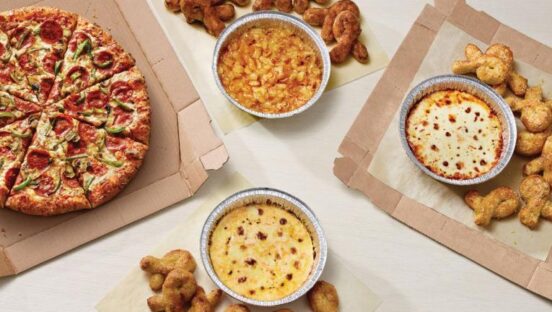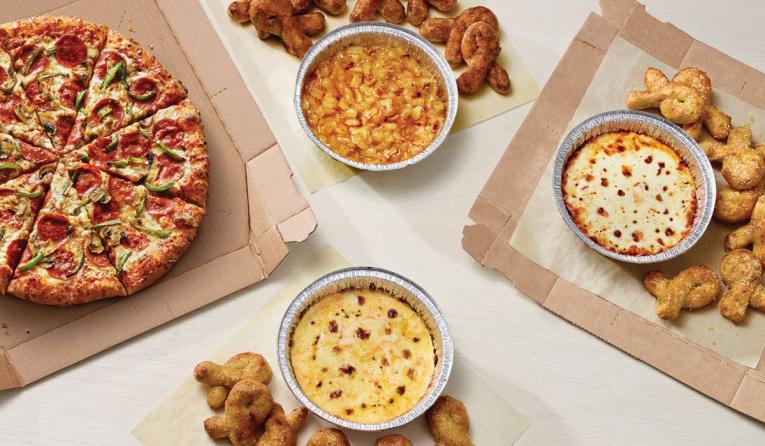Domino’s CEO Russell Weiner said the pizza chain prides itself as a “work-in-progress brand.”
The industry veteran, promoted to his position last May, made these comments amid a challenging delivery environment. Consumers are returning to many pre-COVID habits, including opting for sit-down restaurant occasions instead of delivery. Then there’s the inflationary macroeconomic backdrop. Throughout 2022, customers tightened their wallets, and one of the first things they cut was higher-priced delivery orders. Financial results from Domino’s—a 60 percent delivery business—prove as much.
Same-store sales grew 0.9 percent in Q4, or 13.1 percent on a three-year stack. However, that three-year figure is a 4.5-percentage-point deceleration from Q3, caused by softening demand from delivery customers during the holidays. The channel’s same-store sales declined 6.6 percent year-over-year. On a three-year basis, delivery comps rose 3.3 percent, but that’s down from an 8.4 percent increase in the third quarter.
Comps dipped 0.8 percent in 2022. It was Domino’s first negative comp result on an annual basis since 2008.
Domino’s research shows that relatively higher delivery cost during inflationary periods pushes guests to prepare meals at home. The belief is this dynamic will continue in the short term, as long as customers’ income remains pressured. Weiner also explained since the chain’s model has historically been focused mostly on delivery and carryout, the shift to sit-down experiences hurt them more compared to non-pizza quick-service concepts that had sit down and carryout before COVID, but added delivery afterward.
Because of the headwinds impacting the U.S. delivery business, Domino’s updated its two-to-three-year outlook from 6–10 percent global retail sales growth to 4–8 percent and global net unit growth from 6–8 percent to 5–7 percent.
“As we saw in the last recession, delivery moves with the economy, especially for customers with lower disposable income, who represent a significant portion of our business,” Weiner said during the brand’s Q4 and full-year earnings call. ” … Every day delivery customers will be deciding where to spend their hard-earned dollars. So we need to maintain value and continue to improve our service.”
READ MORE:
Why Domino’s Could Be One of 2023’s Biggest Winners
Domino’s CEO: Brand is as Strong as Ever
Domino’s Evaluating ‘All Options’ as Delivery Woes Continue
Weiner wanted to contextualize where Domino’s stands. To begin, the chain’s delivery business wasn’t alone in facing obstacles. Data from the NPD Group shows the overall quick-service delivery category declined high-single digits in 2022. However, while decreases happened almost everywhere, Domino’s is encouraged by the fact that it moderately gained share in the quick-service pizza delivery space.
Additionally, the pizza chain is still above where it was pre-COVID. The quick-service pizza category saw sales grow 10 percent in three years, and Domino’s gained three share points during this time, the NPD group reported. The company’s U.S. delivery sales in 2022 were more than $500 million higher than 2019.
Domino’s also gained confidence by closing gaps between its best-staffed and lowest-staffed stores. In the fourth quarter, there was only a 2-percentage-point gap in delivery same-store sales between the top quintile of stores and the bottom quintile. That’s a sequential upgrade from Q3 when there was an 8-percentage-point gap. CFO Sandeep Reddy said the 2-percentage-point difference is in line with expected performance in a normal operating environment.
Weiner emphasized that answers exist within the system. One example is deploying 800 custom-branded 2023 Chevy Bolt electric cars at franchise and corporate stores. This gives Domino’s the largest electric vehicle delivery fleet in the country.
Third-party aggregators—delivery as a service and as a marketing platform—are a potential external solution, but Weiner wouldn’t confirm whether Domino’s will seriously explore it in the U.S. The chain has taken a hard stance against it in the past.
“We do work with aggregators globally,” the CEO said. “We’ve got $1 billion in sales outside of the U.S. where we’re learning every day, and while we do that, we’re doing things like continuing to improve our ordering experience.”
In light of delivery struggles, Domino’s carryout business continues to shine. The channel’s retail sales in 2022 were more than $1 billion higher than pre-COVID levels. For perspective, if the brand’s carryout business was a standalone company, it would rank among the top 20 quick-service restaurant brands in the U.S., according to the NPD Group. Same-store sales increased 14.3 percent compared to 2021 and rose 31 percent against Q4 2019. Domino’s gained 200 basis points of market share in the pizza quick-service carryout segment in 2022 and 500 basis points since 2019.
In December, the company brought back its tip campaign in which it gifts online carryout customers a $3 discount for orders placed the following week. During the first run in early 2022, guests claimed more than 17 million carryout tips.
“U.S. carryout remains highly incremental to delivery for us, and in cases where it’s not incremental, customers are moving to a service method with significant lower costs for our system,” Weiner said.
Weiner told investors that Domino’s best chance to win going forward is through value and innovation. Moving the $5.99 Mix and Match offer to $6.99 for delivery and carryout was a good decision, but the CEO added that company-run units and franchisees must be vigilant about value existing across the entire menu. Domino’s took 6.3 percent of price in Q4 and 5.4 percent for the full year.
In terms of innovation, Weiner said the pizza chain peaks whenever it brings ideas to market. Coming out of COVID, he feels the company became too transactional with customers instead of telling “great brand stories.” In early 2023, the brand launched Loaded Tots, achieving a longtime goal of adding a potato side. Later in the year, Domino’s will refresh its Piece of the Pie loyalty program, which first rolled out in the fall of 2015. It holds roughly 30 million active members and more than 77 million total, and Weiner said there’s an opportunity to unlock further value to a wider base of customers.
“Dominos has been called many things over the years; a pizza company, a delivery company, a marketing company, a technology company, all of those are true, but when we are at our best, we’re also an innovation company,” Weiner said. “Product, service, and technology innovation with a very specific purpose; to give our customers and store team members the best possible pizza experience; to tell one-of-a-kind brand stories and to over-deliver on expectations. This is what you have come to expect and should continue to expect from Domino’s Pizza.”
Domino’s opened a net of 1,032 stores in 2022, including 126 in the U.S. and 906 internationally. There were 19,880 restaurants globally as of January 1—6,686 domestically, and 13,194 internationally.











